Earlier this year the Goonhammer Historicals team interviewed Henry Turner of Turner Miniatures, noted designer of STLs for a variety of different historical periods. Henry has been a busy lad since then and has just started a Kickstarter campaign for his latest project – Battleground 1940: Blitzkrieg!
Disclaimer: Thanks to Henry for providing us STLs to use for review purposes.
What All Is Included?
The initial offering (prior to stretch goals and add-ons) is a full set of infantry and support miniatures for both British Expeditionary Force and German Heer. This includes a whole mess of men with rifles, as well as men toting their nations’ respective machineguns, loaders, NCOs with SMGs, and men throwing grenades. For each of these there are loads of poses. I printed an entire platoon of Germans and never re-used any of the STLs apart from a couple of loaders for LMG crews. The range of poses is very nice and will give you a ton of variety when building your force.
The sculpts themselves are intended to represent early war forces – the Germans are all sporting Y-strap harnesses and the Brits all have gas-mask bags on their chests. There are stretch goals to include Germans without the Y-straps and Brits without the gas-mask bags, and as of this writing these are close to being funded. This would extend the usability of these sculpts well into the mid-war period if that’s your jam.
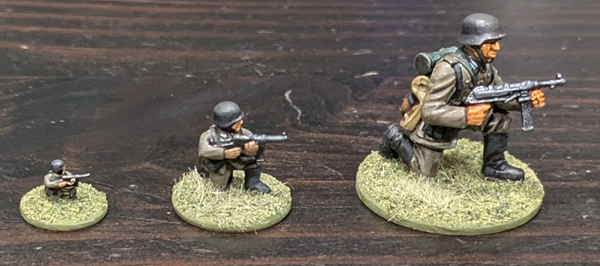
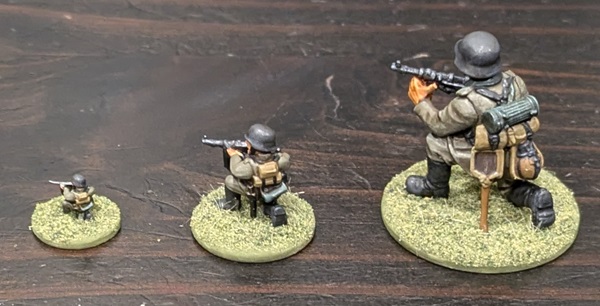
Support miniatures include all of the usual suspects for the early war – mortar crews, snipers, anti-tank rifles, binocular-toting forward observers, radio men, and officers of various types. Oh, and for the Brits: a tiny bag-piper! Again there are loads of poses here, so you’ll have plenty of options to mix things up and have lots of variety in your various weapons teams.
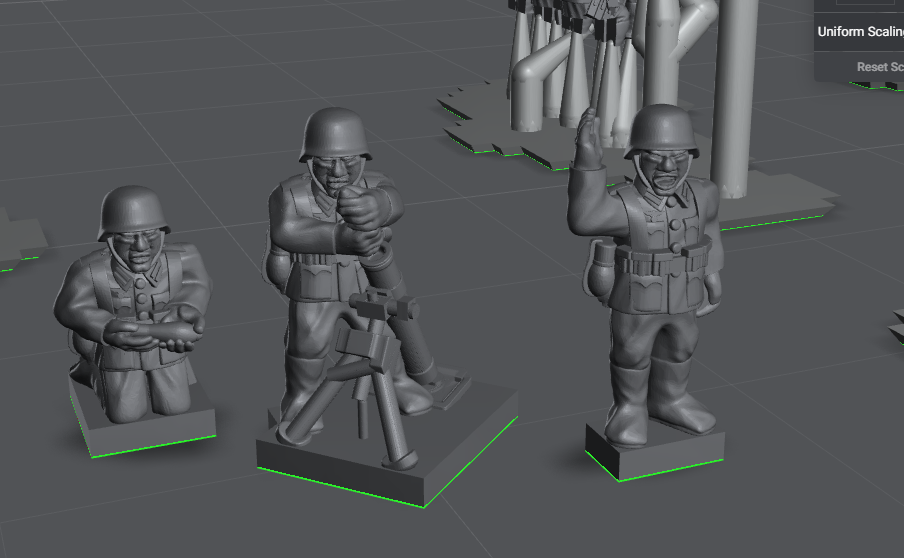
For the basic infantry, these STLs are a dream to work with because they don’t need any kind of additional supports – just import them into your favorite slicer and drop them onto the build plate directly. Anything that needs support – horizontal stuff like aimed rifles or LMGs – already has it built in! Speaking as someone who has spent hours fiddling with supports for various ship and plane STLs, I cannot underscore just how useful and refreshing it is to be able to import these files and just have them work straight out of the gate.
In terms of size, at the default size of the core STLs as delivered, everything is geared for “6mm scale.” I include the quotes there because the actual foot-to-eyeline measurement for these little dudes (the ones who are standing upright, that is) is actually about 7mm. When imported into your favorite slicer they may initially seem a little chonky, but for small-scale miniatures that’s necessary to get the print to turn out right and still have recognizable details.
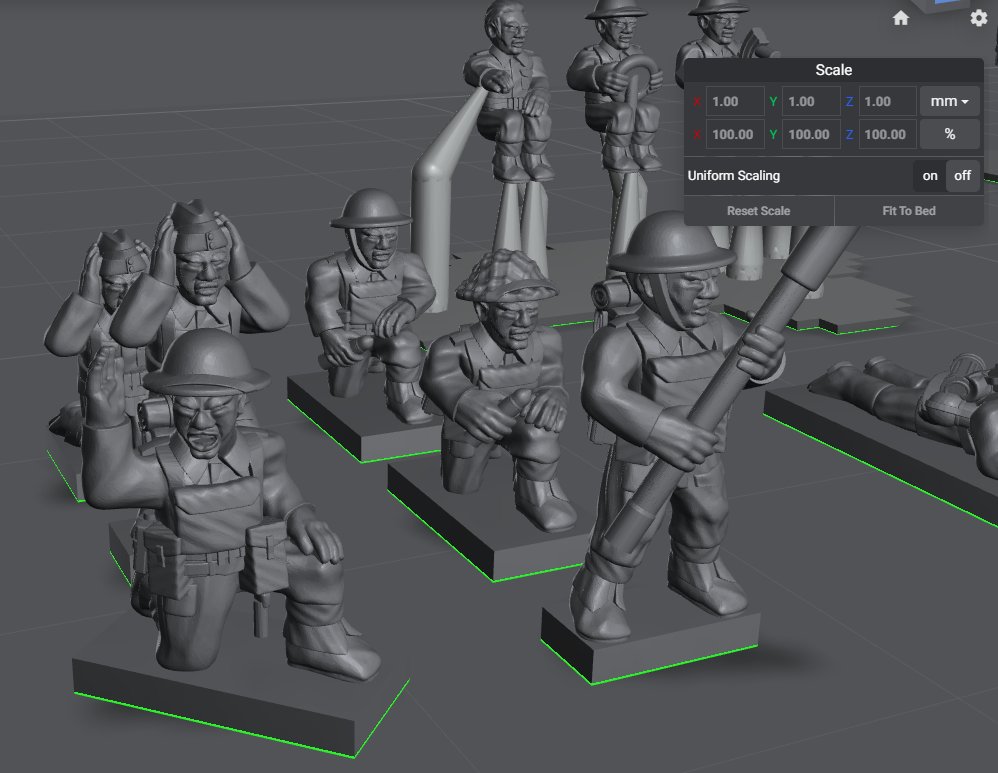
Of course the great thing about 3D-printed miniatures is that resizing the STLs to print at different scales is a simple matter of a few button clicks. Henry’s recommendations of 190% in the X and Y axes and 200% in Z (for standing figures) works great and produces minis that are pretty much spot on for 15mm foot-to-eyeline and will match well with other ranges in that scale. You could go bigger, but I suspect that too much larger and some of the exaggerated detail (really needed at smaller scales) will start to become noticeable. But if 10mm is your chosen scale, working with these will be a breeze and they’ll look great!
What About Add-Ons?
In addition to the British and German infantry and support forces, there are further add-ons for both artillery and tank turrets/crews. The focus in the first of these is for artillery pieces which don’t currently have much in the way of publicly available support. You can easily find stuff like 88 guns and howitzers all over the various STL sites, but some of the more obscure stuff is harder to come by. Even the French 75mm gun – a veritable workhorse of the early war – is not well supported with freely available STLs. Henry’s campaign looks to fill some of these gaps, and he has committed to adding more artillery pieces the more people back this add-on (including a helpful list to aid in your decision-making process). While having full-on artillery on the board as anything other than an objective or special situation at larger figure scales can be a little silly (looking at you, Bolt Action), if you are playing a game at 6mm scale, it’s entirely possible that you could meaningfully be fielding artillery pieces and crews, so having this in your hip pocket could be helpful.
The other add-on that’s pretty cool is the one for various vehicle crews and vehicle turrets with alternate (usually open) cupolas. These sets of STLs are designed to be used in conjunction with one another (especially if you are a Blender user, more on this in a moment) and offer some really nice options. Further, they are designed to work with existing community STLs, such as the ubiquitous (and very nice) Bergman vehicles. This is a great example of the 3D printing community boot-strapping to provide more and better options. Most of the turrets and tank commanders are in 15mm scale, but some (like the German half-track passengers) are in 6mm and will need to be scaled up if you are playing at a bigger scale.
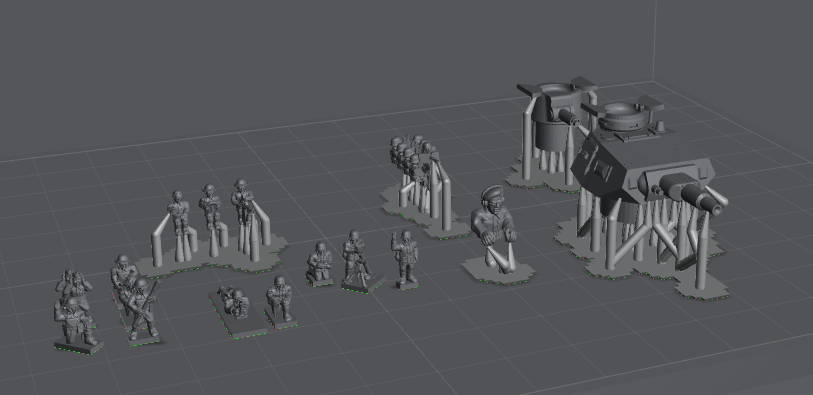

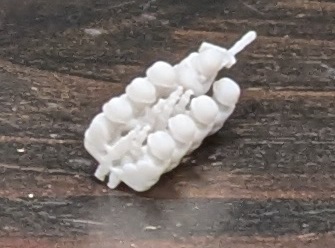
The turrets and commanders are very nice. They’re highly detailed and if you are printing them as separate pieces they go together very nicely. These will need to be supported in your slicer of choice, and I encourage you to be a little overzealous here. I have learned the hard way not to trust Lychee Slicer to guess, so I always end up changing, fiddling, repositioning, and adding supports. But this is pretty quick and easy, and on my printer at least everything came out perfectly once I got my support scheme dialed in.
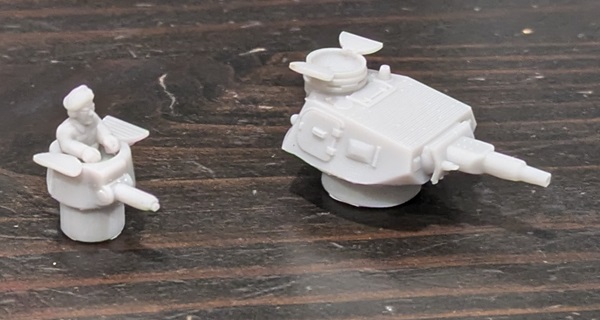
Where I simply printed a commander and open-cupola turret as separate pieces and glued them together in the example above, you could just as easily combine these pieces in your slicer software and create a new STL that is both bits together. This allows them to be printed as a single piece (which is pretty cool), and Henry has some example videos of how to do this on his Kickstarter page.
But Wait, There’s More!
So far I have just been talking about the STLs themselves. But one of the things Henry Turner is known for is offering the source Blender files used to generate those STLs, and this offering is no exception. If you are a Blender user, you can get access to these files as an add-on, which will give you all of the building blocks to take these sculpts and combine, modify, or alter them. Want to do headgear or weapon swaps? Want to turn various bits of kit on or off? This is easy to do in Blender, which gives you even more flexibility over and above the already impressive variety in the core sculpts.
Again, if you’re on the fence about this, Henry has some nice videos linked right from the Kickstarter page that illustrate how all this works and shows the real potential of this approach. I am not a Blender user (indeed, I am a veritable Luddite by this point), but I can really see the appeal here. This kind of “digital kitbashing” is a really cool concept, and if you are a 3d-printing enthusiast who wants to take things to the next level I would highly recommend getting the Blender add-on as a resource for learning and tinkering.
Streeeeeeetch Gooooooaaaals!
As of publication, this project is already funded and going forward, and a number of the stretch goals (including the forces of France) have already been unlocked! British and German motorcycles and side cars, German Sturmpioniers and British Royal Engineers, casualty figures for both sides, the list is already pretty impressive. Just be aware when making your pledge that certain stretch goals are associated with certain add-ons. So if you want the French Sapeurs, these will be included with the core STLs, but the German horse-drawn wagons will be part of the vehicle & crew add-on. These are all clearly labeled, but it’s worth pointing out just for sake of clarity.
The Wash & Cure Stage
Overall, I am really impressed by this offering. It is clear that a ton of effort and detail have been put into this project, and Henry’s passion for accuracy came through in our communications with him during this review (for instance warning us up-front that the initial renders of his great-coated French infantry had the wrong shape for their canteens – a problem he had already corrected!). If the western European theater of WW2 is at all of interest to you, this one is worth checking out. The sheer variety of poses is really nice and the resulting detail on the printed figures is fantastic.
Pundits in the miniature wargaming space have been claiming that the sky is falling for years, that 3D printing will be the death knell of miniature companies. While I think that that is overblown hype, I do think that particularly in the realm of historical games (where not every surface of your tiny warrior is covered in ornate spikes or skulls or crux terminati) things are rapidly approaching that point. For about 45 minutes of print time and a few pennies’ worth of resin, I printed an entire platoon of miniatures in both 6mm and 15mm scales simultaneously and still had oodles of room left over on my build plate. If you have ever fancied getting into a company-scale game like I Ain’t Been Shot, Mum or a battalion-scale game like O-Group, this offering is absolutely worth a look. And to save you the effort of scrolling back up to the top, here’s a handy link to the Kickstarter page!
Are you a 3D-printing enthusiast? What are some of the best (or worst) projects you’ve printed to date? Are you already playing games with 3D-printed armies?Drop us a note in the comments below or email us at contact@goonhammer.com. Want articles like this linked in your inbox every Monday morning? Sign up for our newsletter. And don’t forget that you can support us on Patreon for backer rewards like early video content, Administratum access, an ad-free experience on our website and more.


